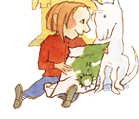        
|
|
Book Selection Criteria
Criteria for the selection of the 2002 Read Up On It are the following:
- books published in Canada or abroad of which the author or illustrator is Canadian;
- books available from bookstores, publishers or public libraries;
- books in English and/or French, with due respect given to geographic distribution and multi-cultural diversity;
- books appropriate for age categories covering 2 to 16 years;
- books from the following categories: fiction, non-fiction and picture books; and
- books in which the quality of text and illustration is evident, as well as the quality of the text in relation to the illustrations.
The definition of "Magic"* as a theme was as follows:
Books that help us to discover the world of fantasy writing and to understand the full significance of this literary genre for young people: a world open to the imaginary, an invitation into dreamlike or magical universes, a place where reality is symbolically transposed, contrasting with the everyday life of the young reader.
Books from various literary genres that explore fantasy:
- Fantasy novels where we meet strange and unusual characters: fairies or devils, ghosts or magical creatures, human beings possessing special powers, magical animals or objects.
- Fantasy tales, generally linear in their narrative structure, that present characters from the fantasy genre. These tales often include phenomenon such as enchantments, metamorphoses and other transformations.
- Non-fiction fantasy books together with pseudo-non-fiction books such as Encyclopédie des créatures magiques, how-to books for young magicians, along with more literary non-fiction based on imaginary works or characters, etc.
- Books and picture books in which tales (traditional stories, fairy tales, modern stories, adaptations, etc.) and short fantasy stories are illustrated, often with great visual imagination.
*These definitions of magic were inspired by Charlotte Guérette's book Au coeur de la littérature d'enfance et de jeunesse (Sainte-Foy, Que.: Éditions La Liberté, 1998).
|
